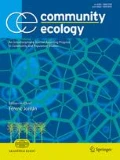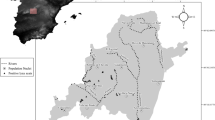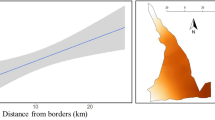Abstract
Iberian lynx distribution is currently restricted to the south of the Iberian Peninsula. Nevertheless, there is evidence of the presence of several small groups in the peninsular centre that have been forgotten by management and conservation actions. In this research, we gathered evidences of Iberian lynx presence along 21 transects located in the southwest of the Madrid province. In these transects lynx DNA was identified in 47 scats, which scientifically proves the presence of the species in that location. Using these locations (presence-only data) we built a maximum entropy model (MaxEnt) to estimate the suitability of the study area for the species. Our results show the existence of an almost continuous area that is approximately 744 km2 that is suitable for the Iberian lynx. Seventy-eight percent of this area is within the Natura 2000 network and, therefore, it falls under regulations to preserve and restore habitat types, flora and fauna. This study shows the suitability of this territory has for the Iberian lynx.
Similar content being viewed by others
Abbreviations
- AUC:
-
Area Under the Curve
- GAM:
-
Generalised Additive Models
- GLM:
-
Generalised Linear Models
- IUCN:
-
International Union for Conservation of Nature
- LOESS:
-
Locally Estimated Scatterplot Smoothing
- NTD5000:
-
National Topographic Database 1:50,000
- PCA:
-
Principal Component Analysis
- SAC:
-
Special Area of Conservation
- SCI:
-
Site of Community Interest
- SDIM:
-
Spatial Data Infrastructure of the Madrid community
- SPAB:
-
Special Protected Area for Birds
References
Alda, F., J., Inogés, L., Alcaraz, J., Oria, A., Aranda and I. Doadrio. 2008. Looking for the Iberian lynx in central Spain: a needle in a haystack? Anim. Conserv. 11:297–305.
Aldama, J. J. 1996. Actuaciones para la conservación del lince ibérico en la C.A.M. LIFE proyect, informe técnico inédito. Madrid.
Arnaiz-Schmitz, C., P. Díaz, D. Ruiz-Labourdette, C. Herrero-Jáuregui, et al. 2018. Modelling of socio-ecological connectivity. The rural-urban network in the surrondings of Madrid (Central Spain). Urban Ecosyst. 21:1199–1212.
Barea-Azcón, J.M., E. Virgós, E. Ballesteros-Duperón, M. Moleón and M. Chirosa. 2007. Surveying carnivores at large spatial scales: a comparison of four broad-applied methods. Biodivers. Conserv. 16:1213–1230.
Beasly, J.C., T.L. Devault, M.I. Retamosa and O.E. Rhodes Jr. 2007. A hierarchical analysis of habitat selection by raccoons in northern Indiana. J. Wildl. Manag. 71:1125–1133.
Beltrán, J.F. and M. Delibes. 1994. Environmental determinants of circadian activity of free-ranging Iberian lynxes. J. Mammal. 75 (2):382–393.
Blanco, J. C., L. Barrios, J.A. González-Oreja, J.G. Fonzález-Vázquez, V. Garza, G. Crema, et al. 1997. Inventario, situación y plan de recuperación del Lince Ibérico en Extremadura. Consejería de Medio Ambiente, Urbanismo y Turismo, Junta de Extremadura.
Boscaje S.L. 2000. Actuaciones para la conservación de las poblaciones de lince ibérico Lynx pardina en la C.A.M. informe técnico inédito. Madrid.
Boshoff, A.F. and G.I. Kerley. 2010. Historical mammal distribution data: How reliable are written records? S. Afr. J. Sci. 106 (1–2):26–33.
Cabezas-Díaz, S., J. Lozano and E. Virgós. 2009. The declines of the wild rabbit (Oryctolagus cuniculus) and the Iberian lynx (Lynx pardinus) in Spain: redirecting conservation efforts. In: Aranoff, J.B. (ed.), 2009. Handbook of Nature Conservation: Global, Environmental and Economic Issues. Nova Science Publishers, pp. 283–310.
Calzada, J., P. Muñoz, A. Sánchez, M.J. Palacios, C. Dávila, M. A. Simón, et al. 2007. Estrategia para la Conservación del Lince Ibérico (Lynx pardinus). Comisión Nacional de Protección de la Naturaleza.
Cardillo, N., A. Purvis, W. Sechrest, J.L. Gittleman, J. Bielby and G.M. Mace. 2004. Human population density and extinction risk in the world´s carnivores. PLOS Biol. 2(7):909–914.
Clavero, M. and M. Delibes. 2013. Using historical accounts to set conservation baselines: the case of Lynx species in Spain. Biodivers. Conserv. 22 (8):1691–1702.
Chávez, C., A. De la Torre, H. Bárcenas, R.A. Medellín, H. Zarza and G. Ceballos. 2013. Manual de fototrampeo para estudio de fauna silvestre. El jaguar en México como estudio de caso. Alianza WWF-Telcel, Universidad Nacional Autónoma de México, México.
Chefaoui, R.M., J. Hortal and J.M. Lobo. 2005. Potential distribution modelling, niche characterization and conservation status assessment using GIS tools: a case study of Iberian Copris species. Biol. Conserv. 122:327–338.
Courchamp, F., T. Clutton-Brock and B. Grenfell. 1999. Inverse density dependence and the Allee effect. Trends Ecol. Evol. 14 (10):405–410.
Creel, S., G. Spong, J.L. Sands, J. Rotella, J. Zeigle, L. Joe, K.M. Murphy and D. Smith. 2003. Population size estimation in Yellowstone wolves with error prone noninvasive microsatellite genotypes. Mol. Ecol. 12 (7).
Cruz, A., B. Matallanas, J. Lobón-Rovira, J.G. Casanovas, G. Alonso and P. Arana. 2019. Double specific nested PCR and diagnostic SNP assay for species identification in lynx fecal critical samples. Conserv. Genet. Resour. 11:173–175.
Delibes, M. 1990. La Nutria (Lutra lutra) en España. Serie Técnica, I.C.O.N.A. Madrid.
Din, J.U. and M.A. Nawaz. 2010. Status of the Himalayan lynx in district Chitral, NWFP, Pakistan. J. Anim. Plant Sci. 20(1): 17–22.
Elith, J., S.J. Phillips, T. Hastie, M. Dudík, Y. Chee and C.J. Yates. 2011. A statistical explanation of MaxEnt for ecologists. Divers. Distrib. 17:43–57.
Ferreras, P., M. Delibes, F. Palomares, J.M. Fedriani, J. Calzada and E. Revilla. 2004. Proximate and ultimate causes of dispersal in the Iberian lynx. Lynx pardinus. Behav. Ecol. 15:31–40.
Fordham, D.A., H.R. Akçakaya, B.W. Brook, A. Rodríguez, P.C. Alves, E. Civantos, M. Triviño, M.J. Watts and M.B. Araújo. 2013. Adapted conservation measures are required to save the Iberian lynx in a changing climate. Nat. Clim. Chang. 3:899–903.
Frankham, R. and J.G. Kingslover. 2004. Response to environmental change: adaptation or extinction. In: Ferrier, R., U. Dieckman and D. Couvet (eds.), Evolutionary Conservation Biology, Cambridge University Press, Cambridge. pp. 85–100.
Frey, J.K., J.C. Lewis, R.K. Guy and J.N. Stuart. 2013. Use of anecdotal occurrence data in species distribution models: An example based on the white-nosed coati (Nasua narica) in the American Southwest. Animals 3(2):327–348.
Fundación CBD-Hábitat. 2006. Análisis de la presencia de otros carnívoros en relación al lince ibérico (Lynx pardinus Temminck, 1827) en Sierra Morena oriental. Conservación del lince ibérico en Sierra Morena oriental. Proyecto LIFE/02/E/NAT/8609 ‘Recuperación de las poblaciones de lince ibérico en Andalucía’. Informe técnico inédito, Madrid.
Gastón, A., S. Blázquez-Cabrera, G. Garrote, M.C. Mateo-Sánchez, P. Beier, M.A. Simón and S. Saura. 2016. Response to agriculture by a Woodland species depends on cover type and behavioral state: insights from resident and dispersing Iberian Lynx. J. Appl. Ecol. 53:814–824.
Gastón, A., S. Blázquez-Cabrera, C. Ciudad, M.C. Mateo-Sánches, M.A. Simón and S. Saura. 2019. The role of forest canopy cover in hábitat selection: insights from the Iberian Lynx. Eur. J. Wildl. Res. 65:30.
García, P. and E. Pérez. 2016. Mapping of soil sealing by vegetation indexes and built-up index: A case of study in Madrid (Spain). Geoderma 268:100–107.
Garrote, G., R.P. de Ayala, P. Pereira, F. Robles, N .Guzmán, F.J. García, et al. 2011. Estimation of the Iberian lynx (Lynx pardinus) populatios in the Doñana area, SW Spain, using capture-recapture analysis of camera-trapping data. Eur. J. Wildl. Res. 57:355–362.
Garrote, G. and R.P. de Ayala. 2015. Assessing unverified observation data used for estimating Iberian lynx distribution. Eur. J. Wildl. Res. 61 (5):801–806.
Garrote, G., J. Fernández–López, G. López, G. Ruiz and M.A. Simón. 2018. Prediction of Iberian lynx road–mortality in southern Spain: a new approach using the MaxEnt algorithm. Anim. Biodivers. Conserv. 41(2):217–225.
Gil-Sánchez, J.M. and E.B. McCain. 2011. Former range and decline of the Iberian lynx (Lynx pardinus) reconstructed using verified records. J. Mamm. 92(5):1081–1090.
Gompper, M.E., R.W. Kays, J.C. Ray, S.D. Lapoint, D.A. Bogan and J.R. Cryan. 2006. A comparison of noninvasive techniques to survey carnivore communities in northeastern North America. Wildl. Soc. Bull. 34(4):1142–1151.
Graells, M.P. 1897. Fauna Mastodológica Ibérica. Real Academia de Ciencias, Madrid.
Graham, M.H. 2003. Confronting multicollinearity in ecological multiple regression. Stat. Rep. 84(11):2809–2815.
Gugolz, D., M.V. Bernasconi, C. Breitenmoser-Würsten, and P. Wandeler. 2008. Historical DNA reveals the phylogenetic position of the extinct Alpine lynx. J. Zool. 275:201–208.
Guisan, A. and W. Thuiller. 2005. Predicting species distribution: offering more than simple habitat models. Ecol. Lett. 8:993–1009.
Guzmán, J.N., G. Garrote, P. García, R.P. de Ayala and M.C. Iglesias. 2002. Censo-diagnóstico de las poblaciones de lince Ibérico (Lynx pardinus) en España. 2000–2002. In: Abstract International 22 Seminar on the Iberian lynx. Madrid.
Guzmán, J.N., F.J. García, G. Garrote, R.P. de Ayala and M.C. Iglesias 2004. El lince ibérico (Lynx pardinus) en España y Portugal. Censo-diagnóstico de sus poblaciones. DGCN, Ministerio de Medio Ambiente, Madrid.
Guzmán, J.N., F.J. García, G. Garrote, R.P. de Ayala and C. Iglesias 2005. El lince ibérico (Lynx pardinus) en España y Portugal. Organismo Autónomo Parques Nacionales. Ministerio de Medio Ambiente, Madrid.
Hair, J.F., R.E. Anderson, R.L. Tatham and C. Black. 1998. Multivariate Data Analysis. (5th ed.). Prentice Hall, New Jersey.
Hijmans, R.J., S.E. Cameron and J.L. Parra. 2006. WorldClim Global Climate Layers Version 1.4. [last use 15 July 2016]. Available in: www.worldclim.org.
Hutchinson, G.E. 1957. Concluding remarks. Cold Spring Harb. Symp. Quant. Biol. 22:415–427.
Iglesias, A. and A.J. España 2010. Rastros y huellas de carnívoros ibéricos. Ediciones Jaguar, Madrid.
James, F.C., R.F. Johnson, N.O. Wamer, G.J. Niemi and W.J. Boecklen. 1984. The Grinellian niche of the Wood Thrush. Am. Nat. 124:17–47.
Johnson, W.E., J.A. Godoy, F. Palomares, M. Delibes, M. Fernandes, E. Revilla and S.J. O´Brien. 2004. Phylogenetic and phylogeographic analysis of Iberian Lynx populations. J. Hered. 95:19–28.
Kohn, M.H. and R.K. Wayne. 1997. Facts from feces revisited. Trends Ecol. Evol. 12 (6):223–227.
Le, S., J. Josse and F. Husson. 2008. FactoMineR: An R Package for Multivariate Analysis. J. Stat. Soft. 25 (1):1–18.
LaRue, P., L. Bélanger and J. Huot. 1995. Riparian edge effects on boreal balsam fir bird communities. Can. J. For. Res. 25:555–566.
Llaneza, L., V. Sazatornil and J.V. López-Bao. 2018. The importance of fine-scale breeding site selection patterns under a landscape-sharing approach for Wolf conservation. Biodivers. Conserv. 27:1239–1256.
Long, R.A., P. MacKay, J. Ray and W. Zielinski (eds.). 2012. Noninvasive Survey Methods for Carnivores. Island Press, Washington.
Mallinson, J. 1978. Lynxes. European lynx (Lynx lynx) and pardel lynx (Lynx pardina). In: Mallinson, J. (ed.), The Shadow of Extinction: Europe’s Threatened Wild Mammals. MacMillan, London. pp. 141–148.
Martín, J., R. Grande, A. Hernando and J. Eliseo (eds.). 2007. Prospección del Lince Ibérico en los montes del centro de España. Fundación Abertis, Cantabria.
Mateo, R.G., A.M. Felicísimo and J. Muñoz. 2011. Species distributions models: A synthetic revision. Rev. Chil. Hist. Nat. 84:217–240.
MDA Federal. 2004. Landsat GeoCover ETM+ 2000 Edition Mosaics Tile N-03-05.ETM-EarthSat-MrSID, 1.0. USGS, Sioux Falls, South Dakota, 2000. [last use 13 July 2015]. Available in: www.landcover.org.
Ministry of Environment and Ordination of the Territory. 2017. Regional Catalogue of Endangered Species of Wild Flora and Fauna, and Unique Trees of Madrid Province. Comunidad de Madrid. [14 Aug 2017]. Available in: http://www.madrid.org.
Molinari-Jobin, A., M. Kéry, E. Marboutin, P. Molinari, I. Koren, C. Fuxjäger, et al. 2012. Monitoring in the presence of species misidentification: the case of the Eurasian lynx in the Alps. Anim. Conserv. 15(3):266–273.
Morris, D.W. 1987. Ecological scale and habitat use. Ecology 68(2):362–369.
Morrison, M.L., B. Marcot and W. Mannan. 2012. Wildlife-habitat Relationships: Concepts and Applications. Island Press, Washington.
Northrup, J.M., M.B. Hooten, C.R. Anderson and G. Wittemyer. 2013. Selection functions under a use –availability design. Ecology 94(7):1456–1463.
Nowell, K. and P. Jackson. 1996. Wild Cats: Status Survey and Conservation Action Plan. IUCN/SSC Cat Specialist Group, Gland, Switzerland.
Palomares, F. 2001. Vegetation structure and prey abundance requirements of the Iberian lynx: implications for the design of reserves and corridors. J. Appl. Ecol. 38:9–18.
Palomares, F., J.A. Godoy, A. Píriz and S.J. O’Brien. 2002. Faecal genetic analysis to determine the presence and distribution of elusive carnivores: design and feasibility for the Iberian lynx. Mol. Ecol. 11(10):2171–2182.
Palomo, L.J., J. Gisbert and J.C. Blanco. 2007. Atlas y Libro Rojo de los Mamíferos Terrestres de España. Madrid Dirección General para la Biodiversidad-SECEM-SECEMU.
Phillips, S.J., R.P. Anderson and R.E. Schapire. 2006. Maximum entropy modeling of species geographic distributions. Ecol. Model. 190:231–259.
Phillips, S.J. and M. Dudík. 2008. Modeling of species distributions with Maxent: new extensions and comprehensive evaluation. Ecography 31:161–175.
Phillips, S.J., M. Dudík, R.E. Schapire. 2019. Maxent software for modeling species niches and distributions (Version 3.4.1). Available from url: http://biodiversityinformatics.amnh.org/open_source/maxent/. Accessed on 2019-1-24.
QGIS Development Team (2017). QGIS Geographic Information System. Open Source Geospatial Foundation Project. Available in: http://qgis.osgeo.org.
Radosavljevic, A., R.P. Anderson. 2014. Making better MAXENT models of species distributions: complexity, overfitting and evaluation. J. Biogeogr. 41:629–643.
R Core Team (2017). R: A language and environment for statistical computing. R Foundation for Statistical Computing, Vienna, Austria. Available in: http://www.R-project.org/.
Rettie, W.J. and F. Messier. 2000. Hierarchical habitat selection by woodland caribou: its relationship to limiting factors. Ecography 23:466–478.
Rodríguez, A. and J. Calzada. 2015. Lynx pardinus. The IUCN Red List of Threatened Species 2015: e.T12520A50655794. http://dx.doi.org/10.2305/IUCN.UK.2015-2.RLTS.T12520A50655794. en. Downloaded on 21 January 2019.
Rodríguez, A. and M. Delibes. 1990. El lince ibérico (Lynx pardina) en España: distribución y problemas de conservación. Colección Técnica, ICONA (former Spanish Institute for Nature Conservation), Madrid, Spain.
Rodríguez, A. and M. Delibes. 1992. Current range and status of the Iberian lynx Felis pardina Temminck, 1824 in Spain. Biol. Conserv. 61(3):189–196.
Rodríguez, J.L. 2003 Guía de Campo de los Mamíferos Terrestres de España. Ediciones Omega, S.A. Barcelona.
Rodríguez, R., O. Ramírez, C.E. Valdiosera, N. García, F. Alda, J. Madurell-Malapeira, et al. 2011. 50,000 years of genetic uniformity in the critically endangered Iberian lynx. Mol. Ecol. 20:3785–3795.
Rodríguez-Varela, R., A. Tagliacozzo, I. Ureña, N. García, E. Crégut-Bonnoure, M.A. Mannino, J.L. Arsuaga and C. Valdiosera. 2015. Ancient DNA evidence of Iberian lynx palaeoendemism. Quat. Sci. Rev. 112:172–180.
Rodgers, T.W. and J.E. Janečka. 2013. Applications and techniques for non-invasive faecal genetics research in felid conservation. Eur. J. Wildl. Res. 59(1):1–16.
San Miguel, A. (Coord). 2006. 1ª reimp. Manual para la gestión del hábitat el lince ibérico (Lynx pardinus Temminck) y de su presa principal, el conejo de monte (Oryctolagus cuniculus L.). Fundación CBD-Habitat, Madrid.
Schmitz, M.F., I. de Aranzabal and F.D. Pineda. 2007. Spatial analysis of visitor preferences in the outdoor recreational niche of Mediterranean cultural landscapes. Environ. Conserv. 34(4):300–312.
Sexton, J.O., X.P. Song, M. Feng, P. Noojipady, A. Anand, C. Huang, et al. 2013. Global, 30-m resolution continuous fields of tree cover: Landsat-based rescaling of MODIS Vegetation Continuous Fields with lidar-based estimates of error. [last use 15 July 2015]. Available in: www.landcover.org.
Simón, M.A. 2017. Censo de las poblaciones de lince ibérico, año 2017. Life + Iberlince website. Available in: www.iberlince.eu.
Simón, M.A., J. Gil-Sánchez, G. Ruiz, G. Garrote, E. Mccain, L. Fernández, et al. 2011. Reverse of the decline of the endangered Iberian Lynx. Conserv. Biol. 26(4):731–736.
Tobler, M.W., S.E. Carrillo-Percastegui, R. Leite-Pitman, R. Mares and G. Powell, 2008. An evaluation of camera traps for inventorying large- and medium-sized terrestrial rainforest mammals. Anim. Conserv. 11:169–178.
Torre, I., A. Arrizabalaga and F. Flaquer. 2003. Estudio de la distribución y abundancia de carnívoros en el parque natural del Montnegre I el corredor mediante fototrampeo fotográfico. Galemys 15 (1):15–28.
Torres, J., R. García-Perea, J. Gisbert and C. Feliu. 1998. Helminth fauna of the Iberian Lynx,. Lynx pardinus. J. Helminthol. 72:221–226.
Valverde, J.A. 1963. Información sobre el lince ibérico en España. Boletín técnico, serie cinegética. Ministerio de Agricultura, Dirección General de Montes, Caza y Pesca Fluvial, Servicio Nacional de Pesca Fluvial y Caza.
Virgós, E. 2001. Relative value of riparian woodlands in landscapes with different forest cover for medium-sized Iberian carnivores. Biodivers. Conserv. 10:1039–1049.
Virgós, E. 1994. Consideraciones sobre la situación del tejón (Meles meles) en algunas áreas del centro de la Península Ibérica. Aegypius 12:37–40.
Virgós, E. and J.G. Casanovas. 1993. Distribución, ecología y conservación de los carnívoros en el Parque Regional de la Cuenca Alta del Manzanares. AEDENAT-CODA, Madrid.
Virgós, E. and A. Travaini. 2005. Relationship betweennsmall-game hunting and carnivore diversity in central Spain. Biodivers. Conserv. 14(14):3475–3486.
Warton, D.I. and L.C. Shepherd. 2010. Poisson point process models solve the “pseudo-absence problem” for presence-only data in ecology. Ann. Appl. Stat. 4(3):1383–1402.
Zabía, M. and L. del Olmo. 2007. Atlas Medio Ambiente de la Comunidad de Madrid. Consejería de Medio Ambiente y Ordenación del Territorio. [14 Aug 2017]. Available in: http://www.madrid.org.
Author information
Authors and Affiliations
Corresponding author
Electronic supplementary material
Rights and permissions
About this article
Cite this article
Alfaya, P., Casanovas, J.G., Lobón-Rovira, J. et al. Using MaxEnt algorithm to assess habitat suitability of a potential Iberian lynx population in central Iberian Peninsula. COMMUNITY ECOLOGY 20, 266–276 (2019). https://doi.org/10.1556/168.2019.20.3.7
Received:
Revised:
Accepted:
Published:
Issue Date:
DOI: https://doi.org/10.1556/168.2019.20.3.7




